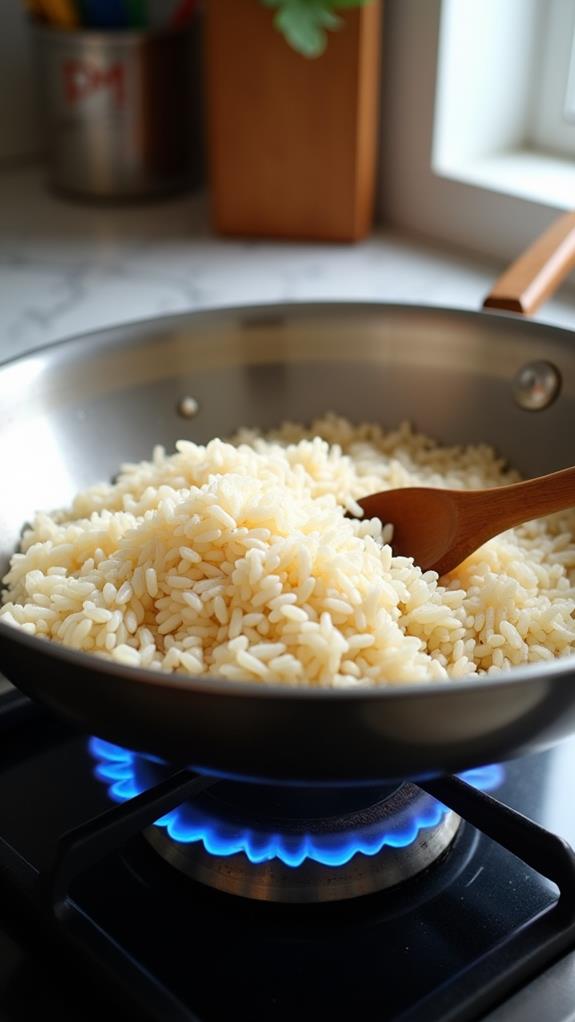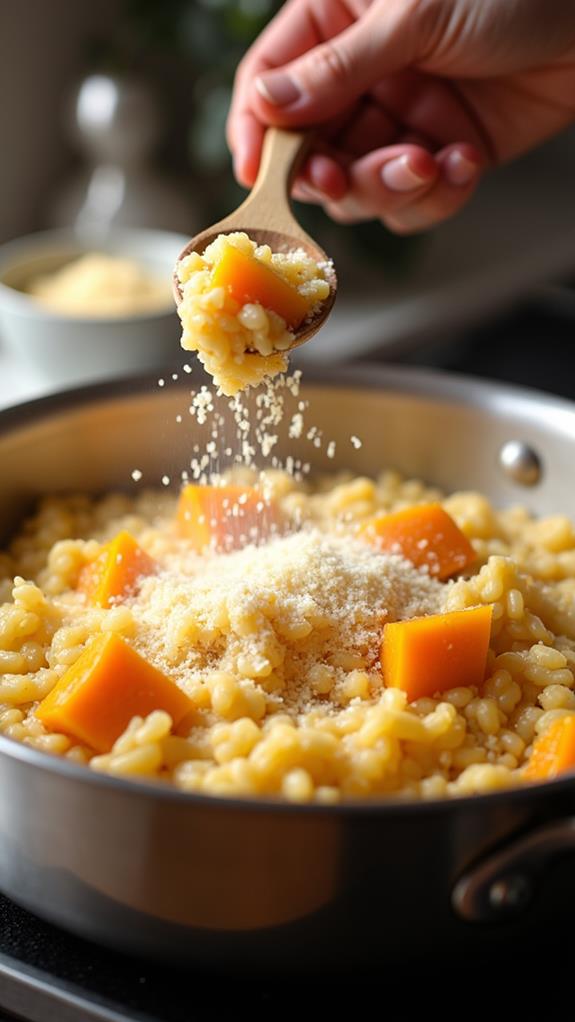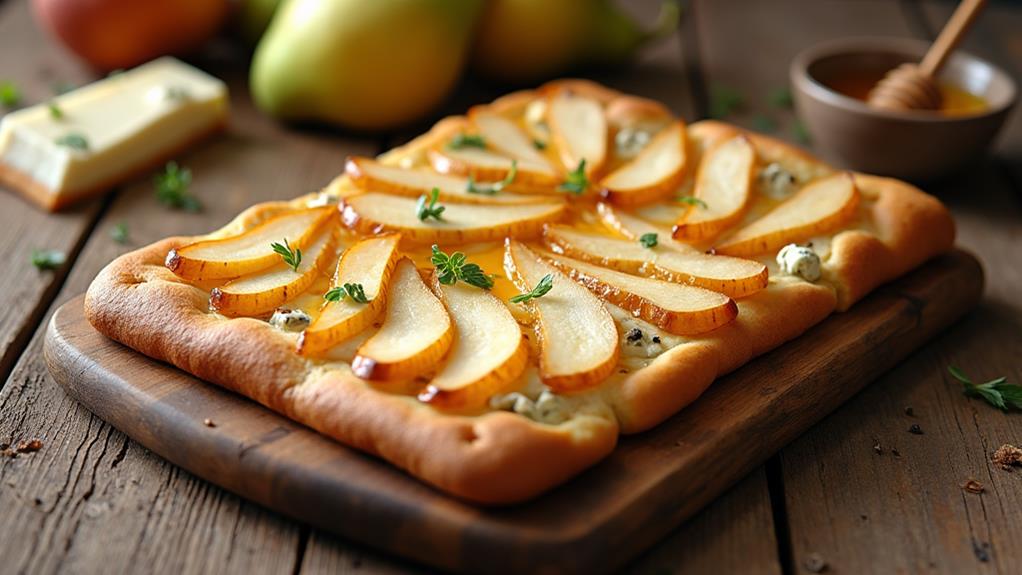Did you know that risotto originated in Northern Italy in the 16th century? This creamy rice dish has since evolved to include countless variations, with butternut squash risotto becoming a popular autumn favorite. You'll find that this comforting meal combines the rich, nutty flavor of roasted squash with the velvety texture of Arborio rice. It's a dish that's both elegant and satisfying, perfect for impressing dinner guests or treating yourself on a chilly evening. If you've never attempted to make risotto before, you might be surprised at how simple it can be with the right technique. Let's explore what makes this dish so special.
Key Takeaways
- Butternut squash risotto combines creamy Arborio rice with sweet, roasted squash for a comforting Italian-inspired dish.
- Key ingredients include Arborio rice, diced butternut squash, vegetable broth, Parmesan cheese, and butter.
- Gradually adding warm broth while stirring constantly is crucial for achieving the perfect creamy texture.
- Roasted butternut squash is folded into the risotto near the end of cooking for optimal flavor and texture.
- The dish pairs well with crisp white wines like Pinot Grigio or light-bodied Chardonnay.
History
Risotto has been a staple in Italian cuisine for centuries, with its origins dating back to the 14th century in northern Italy. You'll find that this creamy rice dish evolved from the introduction of rice cultivation in the Po Valley, where the moist climate proved ideal for growing short-grain rice varieties.
As risotto gained popularity, cooks developed various regional recipes, incorporating local ingredients and flavors. The addition of butternut squash to risotto is a more recent innovation, reflecting the modern trend of combining traditional techniques with seasonal produce.
You'll appreciate how this pairing highlights the versatility of risotto as a canvas for different flavors. When you make butternut squash risotto, you're participating in a culinary tradition that spans generations, while also embracing contemporary tastes.
To create an authentic risotto experience, you'll want to use Arborio rice, known for its high starch content. This characteristic allows the rice to absorb flavors while maintaining a slightly firm texture, creating the creamy consistency that's become synonymous with well-prepared risotto.
Recipe
Butternut squash risotto is a comforting and elegant dish that perfectly captures the flavors of autumn. This creamy Italian rice dish combines the natural sweetness of roasted butternut squash with the rich, velvety texture of perfectly cooked arborio rice.
This simplified version of butternut squash risotto focuses on five key ingredients to create a restaurant-quality meal in your own kitchen. By using high-quality components and paying attention to the cooking process, you can achieve a delicious and impressive result without the need for numerous ingredients or complicated techniques.
- 1 1/2 cups arborio rice
- 2 cups diced butternut squash
- 6 cups vegetable broth
- 1/2 cup grated Parmesan cheese
- 2 tablespoons unsalted butter
- Salt and pepper to taste
Preheat the oven to 400°F (200°C). Toss the diced butternut squash with olive oil, salt, and pepper, then spread on a baking sheet and roast for 25-30 minutes until tender.
In a large pot, bring the vegetable broth to a simmer. In a separate large, heavy-bottomed pan, toast the arborio rice over medium heat for 1-2 minutes. Begin adding the warm broth to the rice, one ladleful at a time, stirring constantly and waiting for each addition to be absorbed before adding more.
Continue this process for about 20-25 minutes until the rice is creamy and cooked al dente. Fold in the roasted butternut squash, Parmesan cheese, and butter. Stir until well combined and season with salt and pepper to taste.
For best results, use room temperature butter and freshly grated Parmesan cheese. Don't be tempted to rush the cooking process by adding all the broth at once; the gradual addition of liquid is crucial for developing the risotto's creamy texture.
If you prefer a smoother consistency, you can purée half of the roasted butternut squash before adding it to the risotto. Finally, serve the dish immediately for the best taste and texture, as risotto tends to thicken as it cools.
Cooking Steps
Begin by dicing the butternut squash and roasting it until tender.
While toasting the Arborio rice in a separate pot, as you gradually add warm broth to the rice, you'll need to stir constantly, ensuring the risotto develops its signature creamy texture.
Once the rice is cooked al dente, fold in the roasted squash, grated Parmesan cheese, and a pat of butter.
Continue to stir until all ingredients are well combined and the risotto reaches the perfect consistency.
Step 1. Dice Butternut Squash

The first step in creating your butternut squash risotto is to prepare the squash itself. Begin by washing the squash thoroughly under cool water, ensuring you've removed any dirt or debris from its skin.
Next, carefully cut off both ends of the squash using a sharp chef's knife. Stand the squash upright on your cutting board and, using a vegetable peeler or the knife, remove the tough outer skin.
Once peeled, cut the squash in half lengthwise and scoop out the seeds and stringy pulp with a spoon. You'll now have two long halves of clean, peeled squash.
Lay each half flat on your cutting board and slice it into 1/2-inch thick half-moons. Then, cut these half-moons into 1/2-inch cubes.
It's important to keep the cubes relatively uniform in size to ensure even cooking.
As you dice, you'll notice the squash's vibrant orange flesh. This color indicates its rich nutritional content, packed with vitamins and antioxidants.
Your diced butternut squash is now ready to be roasted, bringing out its natural sweetness and adding depth to your risotto.
Step 2. Toast Arborio Rice

Toasting Arborio rice is a crucial step in creating a flavorful risotto. To begin, heat a large, heavy-bottomed pan over medium heat. Add a tablespoon of olive oil or butter, swirling to coat the bottom of the pan.
Once the oil is hot, add your Arborio rice and stir constantly for about 2-3 minutes. You'll notice the rice grains becoming slightly translucent around the edges while maintaining a white center.
This process, known as "toasting," helps to seal the exterior of the rice grains, allowing them to slowly absorb liquid without becoming mushy. As you toast the rice, you'll also develop a nutty aroma that adds depth to your risotto's flavor profile.
Be careful not to brown the rice, as this can lead to a bitter taste. Instead, aim for a light golden color and a fragrant scent.
Once your rice is properly toasted, you're ready to begin adding broth and creating the creamy texture that's characteristic of a perfect risotto. Remember, patience is key during this step, as rushing can result in unevenly cooked rice.
Step 3. Add Broth Gradually, Stir Constantly

Gradually adding broth is the cornerstone of creating a creamy butternut squash risotto. You'll want to start by heating your vegetable broth in a separate pot, keeping it warm throughout the cooking process.
Once your rice is toasted, begin adding the warm broth one ladleful at a time. Stir constantly as you add each portion, allowing the rice to absorb the liquid before adding more.
This slow and steady approach is crucial for developing the risotto's signature texture. As you stir, the rice releases its starches, creating a creamy consistency without the need for cream.
You'll notice the mixture becoming increasingly thick and velvety with each addition of broth. Don't rush this step; it typically takes about 18-20 minutes to achieve the perfect al dente texture.
Keep stirring and adding broth until the rice is tender but still has a slight bite to it. If you run out of broth before the rice is fully cooked, you can use hot water to finish the process.
Step 4. Fold in Roasted Squash

Once your risotto has reached the perfect creamy consistency, it's time to incorporate the star ingredient: roasted butternut squash.
Gently fold the tender, caramelized cubes into the rice, distributing them evenly throughout the dish. As you combine the squash with the risotto, you'll notice its vibrant orange color infusing the creamy rice, creating a visually appealing dish.
Be careful not to overmix, as you want to maintain the integrity of the roasted squash pieces. The goal is to have distinct bites of squash interspersed within the creamy risotto base.
As you fold, you'll also release the squash's natural oils and flavors, further enhancing the dish's overall taste profile. If you've roasted the squash with herbs or spices, these will now meld with the risotto, adding depth and complexity to the flavor.
Once you've incorporated the squash, give the risotto a final stir to ensure everything is well combined. The result should be a harmonious blend of creamy rice and sweet, tender butternut squash, ready to be served and enjoyed.
Step 5. Add Cheese and Butter

With the squash incorporated, it's time to add the final touches that elevate your risotto to creamy perfection. Grab your freshly grated Parmesan cheese and a pat of high-quality butter. These ingredients are crucial for achieving the luxurious texture and rich flavor that make risotto so irresistible.
Add about a half cup of Parmesan cheese to the pot, stirring gently to distribute it evenly throughout the rice. The heat from the risotto will melt the cheese, creating a silky consistency.
Next, drop in a tablespoon of butter and continue stirring. As the butter melts, it'll add a glossy sheen to your dish and enhance its velvety mouthfeel.
Keep stirring for another minute or two, allowing the cheese and butter to fully incorporate. You'll notice the risotto becoming even creamier and more cohesive.
Taste and adjust the seasoning if needed, adding a pinch of salt or pepper to balance the flavors. Remember, the Parmesan adds saltiness, so be cautious not to over-season.
Your butternut squash risotto is now ready to serve, boasting a perfect harmony of flavors and textures.
Final Thoughts
This simple yet elegant butternut squash risotto is sure to impress your dinner guests or provide a comforting meal for yourself. With just five key ingredients, you've created a dish that rivals those found in high-end restaurants.
Remember, the key to perfect risotto lies in the stirring process, so don't skimp on this crucial step.
As you savor your creation, consider experimenting with additional flavors in future attempts. A sprinkle of fresh sage or a dash of nutmeg can elevate the dish even further.
You might also try substituting butternut squash with other seasonal vegetables, such as pumpkin or sweet potato, to create your own unique variations.
Don't forget to pair your risotto with a complementary wine, such as a crisp Pinot Grigio or a light-bodied Chardonnay. These wines will enhance the flavors of the dish without overpowering them.
Lastly, store any leftovers in an airtight container in the refrigerator for up to three days. When reheating, add a splash of broth or water to restore the creamy consistency.













